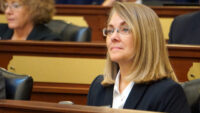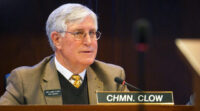The Opportunity Scholarship is in line for a $7 million increase.
The new money, approved unanimously by the Joint Finance-Appropriations Committee, would fund at least 2,000 additional college scholarships next year — and cut into unmet demand.
The need- and merit-based Opportunity Scholarship is the state’s centerpiece financial aid award, and part of a multimillion-dollar campaign to convince high school graduates to continue their education. This year, Idaho is awarding $13.5 million in scholarships. Boosting the program to $20.5 million is one of Gov. Brad Little’s top budget priorities.
Even with this year’s $13.5 million — a record Opportunity Scholarship budget — more than 3,400 eligible students remain on a waiting list.
Legislative budget-writers did some maneuvering to honor Little’s request. They voted to siphon the $7 million from a savings account that provides a backstop for the scholarship.
JFAC has already drawn down the Idaho Opportunity Scholarship Account this session, proposing a $3.1 million transfer to help cover Little’s request to double spending on early reading programs. That transfer, and the $7 million approved Tuesday, would leave about $8.5 million in the savings account.
While approving the transfer, budget-writers acknowledged a need to keep an eye on the savings account. On Tuesday, the committee instructed the State Board of Education to submit a report by January — outlining the account balance and any need to transfer money to cover scholarships in 2020-21.
The State Board has needed to transfer money from the savings account to cover its scholarship obligations. That includes a $1.3 million transfer last year, which was necessary because the State Board had more takers for the scholarship than it had anticipated.
The Opportunity Scholarship budget bill still must pass the House and Senate.
House passes K-12 school budgets
The House of Representatives got into a groove Tuesday and efficiently passed all seven public school budgets.

In less than 30 minutes — and without any debate in opposition — legislators approved a 6.1 percent increase in K-12 spending for 2019-20. That corresponds to an increase of $109 million.
“We are doing our best to keep the pedal to the metal to spend and dedicate as much funds as we can to K-12,” said Rep. Wendy Horman, an Idaho Falls Republican who worked on the school budgets. “This is a significant increase.”
Budget highlights include:
- $49.7 million to pay for the fifth year of educator raises under the 2015 career ladder law.
- $14.6 million in new funding for discretionary spending for districts, a pool of money sometimes called operations funding. Of that total, about $7.5 million would be available to help schools address rising health care costs.
- An additional $13.1 million to expand Idaho’s K-3 literacy initiative, a top priority for Little.
- $7.3 million to give administrators and classified staff a 3 percent raise.
- $7.2 million to pay for financial incentives known as master educator premiums, designed to reward the state’s most effective and experienced educators.
Notably, two House Education Committee members voted against five of the seven budgets. Reps. Dorothy Moon, R-Stanley, and Tony Wisniewski, R-Post Falls, voted against the same five budgets without explaining their opposition.
In reflecting on the budgets’ passage, Horman called the career ladder funding a significant accomplishment.
“It says the Legislature made a commitment and we have honored that commitment,” Horman said. “We support the work of our teachers.”
Overall, K-12 spending accounts for about 49 percent of all state general fund spending.
All seven bills head to the Senate next.
The House also approved the 2019-20 budget for the STEM Action Center. Legislators approved a .4 percent increase in general fund spending for the center, and transferred $1 million from the general fund to the STEM Education Fund for the computer science initiative.
How they voted:
K-12 administrators budget, passed, 64-6. No votes: Vito Barbieri, R-Dalton Gardens; Chad Christensen, R-Ammon; Tammy Nichols, R-Middleton; Heather Scott, R-Blanchard; Moon; Wisniewski.
K-12 teachers budget, passed, 61-9. No votes: Priscilla Giddings, R-White Bird; John Green, R-Post Falls; Christy Zito, R-Hammett; Barbieri; Christensen; Moon; Nichols; Scott; Wisniewski.
K-12 operations budget, passed, 59-9. No votes: Barbieri; Christensen; Giddings; Green; Moon; Nichols; Scott; Wisniewski; Zito.
K-12 children’s budget, passed, 61-9. No votes: Barbieri; Christensen; Giddings; Green; Moon; Nichols; Scott; Wisniewski; Zito.
K-12 facilities budget, passed, 63-7. No votes: Rod Furniss, R-Rigby; Barbieri; Christensen; Giddings; Moon; Nichols; Wisniewski.
K-12 central services budget, passed, 70-0.
K-12 deaf and blind budget, passed, 68-1. No vote: Christensen.
STEM budget, passed, 59-11. No votes: Barbara Ehardt, R-Idaho Falls; Bryan Zollinger, R-Idaho Falls; Barbieri; Christensen; Giddings; Green; Moon; Nichols; Scott; Wisniewski; Zito.
Funding formula discussions continue
House Education made small steps Tuesday toward reaching consensus over some aspects of a proposal to rewrite Idaho’s public school funding formula.
But with legislative leaders working toward adjourning the session later this month, a sense of urgency began to develop. For the 58th consecutive day under the Statehouse rotunda, legislators did not introduce a bill to rewrite the formula.

“We don’t have much time. If we’re going to advance (a draft bill to an introductory hearing) we have to make a decision and move forward,” said Chairman Lance Clow, R-Twin Falls.
“Part of the prerogative of the chairman is when to bring (a draft bill) forward (for introduction),” Clow said. “I’m getting pressure to do that, to make sure we get this moving forward so the entire public can see everything.”
It is important to note any changes to the funding formula would not take effect until 2020-21. Changing the formula would not affect the 2019-20 K-12 budget bills the House passed Tuesday.
As they did Monday, committee members debated a draft bill that has yet to be introduced and therefore is not available to the public at large. However, two legislators and one school administrator provided copies of two different drafts to Idaho Education News to review.
In the Legislature, draft bills are treated as the private property of the drafters and do not become public until they are taken up during an introductory hearing, which is sometimes called a print hearing in legislative lingo.
During Tuesday’s 90-minute meeting, legislators appeared to reach consensus over a few aspects of the proposal.
- They agreed to remove a controversial wealth adjustment that would have provided additional funding weights based on school districts’ property value.
- They agreed to remove a proposed mandate to provide funding weights for gifted and talented students. Instead, it will be up to the Legislature to decide on this funding weight.
- As for other funding weights — for English language learners, special education students and economically disadvantaged students — the committee appeared to agree to set a minimum “floor” weight of 10 percent in 2021 and then leave it up to the Legislature to decide whether to increase that percentage in subsequent years, rather than ramping up the weight by a set amount each year.
- They also appeared to agree on protection to provide all school districts a funding increase for the initial three years after a new formula is established. Legislators appeared to favor ensuring a funding increase of at least 2 percent — but not more than 7.5 percent.
Even in making small elements of progress, Tuesday’s discussion was confusing and tended to get bogged down in the weeds. In one instance, legislators wrestled for about 30 minutes over whether to use the word “addition” in the section addressing funding weights.
Legislators also moved back and forth between two different versions of draft bills — the March 1 draft discussed Monday and a new draft printed Monday afternoon. Some legislators had trouble keeping the competing drafts separate and Clow even said at one point he wasn’t sure if he had seen the more recent draft.
“I think we should all have both at this point,” Ehardt said.
Potentially adding to the intrigue, Rep. Judy Boyle, R-Midvale, said legislators may attempt to introduce competing funding formula bills — one developed by the Legislature’s Public School Funding Formula Interim Committee and one that the House and Senate education committees have been working on, in an attempt to build consensus.
“We can compare them side by side,” Boyle said.
Budget-writers OK community college budget
JFAC wrapped up its work on education budgets by approving a spending plan for Idaho’s four community colleges.
The colleges would receive about $47.8 million from the state’s general fund, a 3.5 percent increase. That increase mirrors the proposed budget for the state’s four-year institutions.
The committee also passed this budget unanimously. The bill now must pass the House and Senate.
Idaho Education News reporter Clark Corbin contributed to this report.
